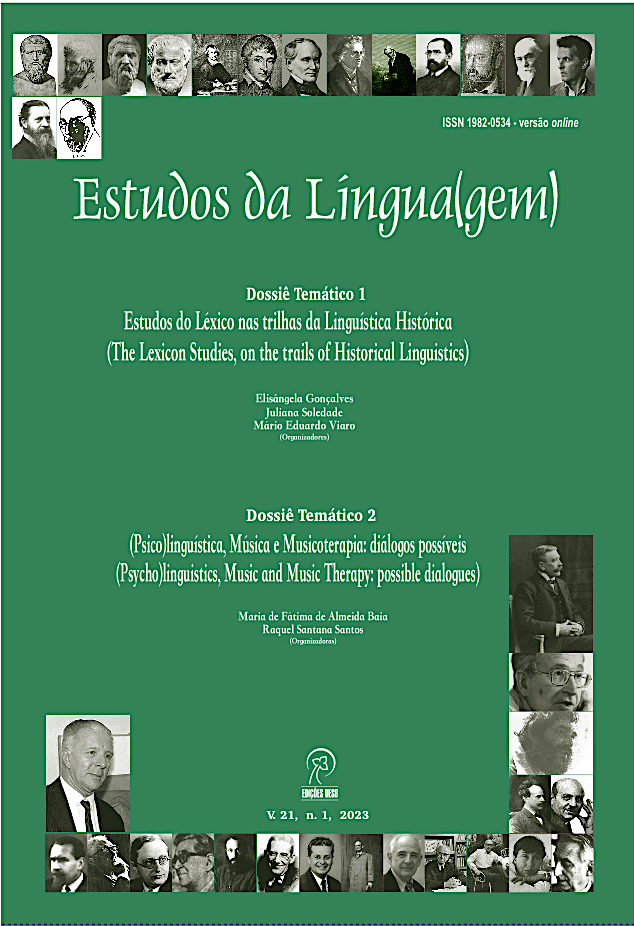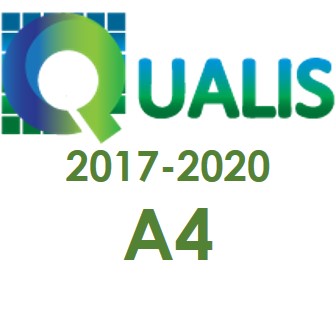Estudo acústico de cinco qualidades de voz com uma nota sustentada (Acoustic study of five voice qualities with a sustained note)
DOI:
https://doi.org/10.22481/el.v21i1.13382Palavras-chave:
Qualidade da Voz; Canto; Parâmetro espectral.Resumo
Este trabalho analisa cinco diferentes qualidades de voz com C4 sustentado (262 Hz), a saber: a) voz soprosa (Br); b) voz fraca (W); c) voz modal (M); d) voz estridente (Cr); e e) voz tensa (T). Foram analisados 13 parâmetros: H1, H1H2, H1A3, CPP, Energia, Razão harmônico-ruído (0-500, 0-1500, 0-2500, 0-3500, F1, F2, B1, B2. Os resultados estatísticos mostraram que os parâmetros diminuem da seguinte maneira: 1) H1: M > Br > T > Cr > W; 2) H1H2: W > Br > (M = Cr) > T; 3) H1A3: (W=Br) > M > Cr > T; 4) B1: T > W > Br > M > W; 5) B2: M > T > Cr > Br > W; 6) CPP: T > M > Br > Cr > W; 7) Energia: T > M > Cr > Br > W. Além disso, HNR apresentou o mesmo padrão decrescente para as quatro condições (W > M > T > Br > Cr), e os formantes F1 e F2 também apresentaram um padrão decrescente semelhante ( T > M > Br > Cr > W).
Downloads
Referências
BALL, M. J.; J., ESLING, J; DICKSON, C. The voqs system for the transcription of voice quality. Journal of the IPA, v. 25, issue 2, p. 71-80, 1995. doi:10.1017/S0025100300005181, 1995.
BOERSMA, P.; WEENINK, D. Praat: Doing phonetics by computer (version 4.5.06). http://www.praat.org/ (Last viewedDecember 8, 2010), 2006.
CATFORD, J. C. Fundamental Problems in Phonetics. Edinburgh University Press, Edinburgh, 1977.
CHOI, H-S.; BERKE, G. S.; YE, M.; KREIMAN, J. Function of the posterior cricoarytenoid muscle in phonation: In vivo laryngeal model, Otolaryngol Head Neck Surg, v. 109, p. 1043-51, 1993.
CHOI, H-S.; BERKE, G. S.; YE, M, Functions of the Interarytenoid (IA) muscle in phonation: in vivo laryngeal model, Yonsei Medical Journal, vol. 36, n.1, 1995.
DALLASTON, K.: DOCHERTY, G. The quantitative prevalence of creaky voice (vocal fry) in varieties of English: A systematic review of the literature. PLoS ONE, v. 15, n. 3, e0229960, 2020.
DICANIO, C. T. The phonetics of register in takhian thong chong. Journal of the IPA, v. 39, n. 2, p. 162-188, 2009.
EDMONDSON, J. A.; ESLING, J. H. The valves of the throat and their functioning in tone, vocal register, and stress: Laryngoscopic case studies. Phonology 520, v. 23, n. 2, p. 157-191, 2006.
GORDON, M. LADEFOGED, P. Phonation types: a crosslinguistic overview, J. of Phonetics, v. 29, p. 383-406, 2001.
ESLING, J. H. There are no back vowels: The laryngeal articulator model. Canadian Journal of Linguistics, v. 50, p. 13-44, 2005.
ESLING, J. H.; MOISIK, S. R.; BENNER, A.; CREVIER-BUCHMAN, L. Voice Quality: The Laryngeal Articulator Model. Cambridge University Press, Cambridge, 2019.
HERBST, C. T. Evaluation of Various Methods to Calculate the EGG Contact Quotient. KTH Speech Music and Hearing, Sweden, Stockholm, Phd Thesis, 2004.
HERBST, C. T. Investigation of four distinct glottal configurations in classical singing—A pilot study. The Journal of the Acoustical Society of America, v.125, EL104, 2009.
HERBST, C. T, HOWARD, D.; SCHLÖMICHER-THIER, J. Using Electroglottographic Real-Time Feedback to Control Posterior Glottal Adduction during Phonation. Journal of Voice, Vol. 24, Issue 1, January 2010, p. 72-85, 2010.
HOLLIEN, H. On vocal registers. Journal of Phonetics, v. 2, p. 125-143, 1974.
KEATING, P.; ESPOSITO, C. M.; GARELLEK, M.; KHAN, S. U. D.; KUANG, J. Phonation Contrast across languages, UCLA Working Papers in Phonetics, no. 108, p. 188-202, 2010.
KLATT, D.; KLATT, L. Analysis, synthesis, and perception of voice quality variations among female and male talkers, J. Acoustic. Soc. Amer., Vol. 87, p. 820-857, 1990.
HILLENBRAND, J.; CLEVELAND, R. A; ERICKSON, R. L. Acoustic correlates of breathy vocal quality, J. Speech and Hearing Research, v. 37, p. 769–778, 1994.
LAVER, J. The phonetic description of voice quality. Cambridge University Press, Cambridge, 1980.
LAVER, J.; MACKENZIE-BECK, E J. Vocal prole analysis scheme: A user's manual. Speech Science Research Centre, Queen Margaret University College-585 QMUC, 2007.
MEIRELES, A.; MIXDORFF, H.. Voice quality in low and high registers in two different styles of singing, in: Proc. Speech Prosody 2020, Tokyo, Japan. p. 5 pages, 2020.
SHUE, Y.-L. The Voice Source in Speech Production: Data, Analysis and Models, PhD Thesis, UCLA, 2010.
SHUE, Y.-L; KEATING, P.; VICENIK, C.; YU, K. Voicesauce: A program for voice analysis, Proceedings of the ICPhS XVII, 2011. P. 1846-1849.
STROSS, B. Falsetto voice and observational logic: Motivated meanings. Language in Society, v. 42, p. 139-162, 2013.
VENNARD, W.; HIRANO, M. Physiological Basis for Vocal Registers. The Journal of the Acoustical Society of America, v. 47, 120, 1970.
YUMOTO, E.; GOULD, W.; BAER, T, Harmonics-to-noise ratio as an index of the degree of hoarseness, J. Acoust. Soc. Am. V.71, p. 1544– 1550, 1982.
Downloads
Publicado
Como Citar
Edição
Seção
Licença

Este trabalho está licenciado sob uma licença Creative Commons Attribution 4.0 International License.
Autores que publicam em Estudos da Língua(gem) concordam com os seguintes termos:
Estudos da Língua(gem) mantém os direitos autorais das contribuições publicadas e disponibiliza seu conteúdo gratuitamente por meio do portal. Autores têm permissão e são estimulados a publicar e distribuir seu trabalho online em repositórios institucionais ou na sua página pessoal, com reconhecimento de autoria e créditos de publicação inicial nesta revista, indicando endereço online.






